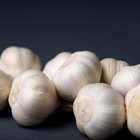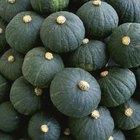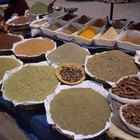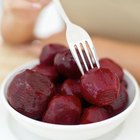canyonos/iStock/GettyImages
Switching to whole spices can be disconcerting for cooks who grew up knowing them only as dull-colored powders in identical jars. The difference between fresh and dried is especially stark with ginger, which instead of a pale yellow powder is a fresh, juicy root. Many recipes begin by peeling the ginger, but the peel is edible and that step is usually optional.
About Ginger
Ginger belongs to a large and varied family of tropical plants, which includes cardamoms, turmeric and even bananas. Like potatoes, the large hand-shaped rhizomes will sprout new ginger plants if they're given the opportunity. Ginger contains a number of volatile compounds, giving it a bright, citrusy, peppery flavor when it's fresh. Some of those volatile compounds are lost when the ginger is dried, and others change their chemical structure, which is why dried ginger is both stronger and less complex than fresh.
The Peel and Rhizome
Ginger rhizomes are pale yellow and very juicy inside, with a thin, tan-colored skin. The skin is removed before ginger is dried and ground, but fresh ginger is almost always sold with the peel on. When the ginger is at its freshest, the skins are thin, smooth and have a faint sheen. As the rhizomes age they lose moisture and shrink, and their peel becomes increasingly thick and woody. Like the skin of the potato, it's entirely edible and -- like the rest of the root -- high in fiber, so deciding whether or not to leave it on is a personal and aesthetic choice.
Peel On or Off
When ginger is sliced thinly for soups, sauces and broths, the skin can be left on as a time-saver for the cook. Even a thick, woody skin can't be detected when the ginger is sliced very thinly, and the slices are often removed from the finished product before serving. If the ginger is to be marinated, pickled or shredded and fried as a garnish to the main dish, it's usually peeled to give the ginger a better appearance. Peels can be left on slices used in tea or other beverages, and this is often a way to use up the flavorful but unsightly skins peeled from the ginger for other uses.
When and How to Peel
It's best to remove the peel once the ginger begins to dry and shrivel, and especially if it displays visible signs of mold. At this stage the best tool for removing the peel is a small, sharp paring knife. When the ginger is fresher and the peel is thin and fine, you can use a conventional peeler to remove it. Alternatively, scrape the peel using the dull back of a knife rather than cutting it away with the sharp blade. Some cooks prefer to use the edge of a spoon, which removes the skin without wasting any of the flesh underneath.
Related Articles
What Fruits Have Edible Peelings?

How to Cook With Lemon Zest & Peel

How to Blanch and Peel Garlic

Can You Eat Celery Root Without Cooking ...

About Fresh Ginger Substitutes

Can You Use an Eggplant if It Has ...

Can I Eat the Peel on Kombucha Squash?

Can You Eat Clementines With the Peel?

Nigerian Herbs & Spices

How to Remove a Cardamom Seed From a Pod

Galangal Powder Substitute

What Herbs & Spices Flavor Fish?

How to Boil Beetroot

How to Store Shallots
How to Eat Asian Pears
Do English Cucumbers Have to Be Peeled ...

How to Keep Pineapple From Browning

How to Oven-Dry a Bitter Gourd

Peeling the Spiny Chayote Squash

How to Juice Pineapple Skin
References
- On Food and Cooking: The Science and Lore of the Kitchen; Harold McGee
- On Cooking: A Textbook of Culinary Fundamentals; Sarah Labensky, et al.
- Fine Cooking: Cooking With Fresh Ginger
Writer Bio
Fred Decker is a trained chef and prolific freelance writer. In previous careers, he sold insurance and mutual funds, and was a longtime retailer. He was educated at Memorial University of Newfoundland and the Northern Alberta Institute of Technology. His articles have appeared on numerous home and garden sites including GoneOutdoors, TheNest and eHow.